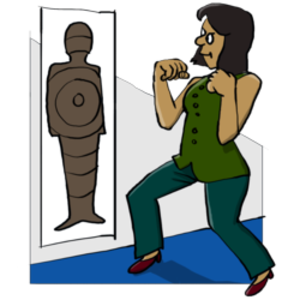Breathing Problems During Sleep and the Heart

We have talked about the importance of heart rate variability (HRV), which reflects the activity of many critical bodily functions. HRV is the result of a subtle interplay between the heart and the nervous system, and abnormalities in HRV may be an early warning of severe illness and even of death.
There are many reasons why peoples’ breathing can become disturbed during the night, and it is essential to be sure that we are treating the right thing.
In obstructive sleep apnea (OSA) the body stops breathing during sleep. The most common reason for OSA is swelling of the tissues at the back of the throat that then block the airway.
In central sleep apnea (CSA) is a breathing decreases or stops during sleep. It may occur as a result of a problem in the sleep centers in the brain, and/or the nerves supplying the heart. It usually follows a cycle, with people breathing normally for a while and then slowing or stopping altogether.
Continuous positive airway pressure (CPAP) that provides a steady stream of pressurized air is often the best treatment for sleep apnea.
There is a close relationship between breathing and the heart, and new research from the Alfred Hospital and Monash University in Melbourne, Australia has looked at a sleep-related breathing disorder that is common in heart failure, and increases HRV.
The researchers looked at the breathing patterns of 21 patients with heart failure who had sleep-related breathing disorder.
They found that as people transitioned from stable breathing to a sleep-related breathing disorder, there was an associated increase in HRV.
On the other hand, people with central sleep apnea (CSA) and obstructive sleep apnea (OSA) produce different patterns of HRV, suggesting that they each involve different mechanisms in the heart and the brain.
This may sound esoteric, but it is not.
Breathing problems during sleep are common and so is heart failure. Unfortunately heart failure carries a high mortality rate, and it is very valuable to have simple tests to guide us to give the correct treatment.
Simply measuring HRV during sleep will give us an idea about whether or not a person with heart failure is stable, or if we need to change treatments before he or she starts getting symptoms.
“All the energy that is used in the creation of every cell in the universe is on that breath that you are breathing in.”
–George King (English Spiritual Teacher, Writer and Founder of the Aetherius Society, 1919-1997)
“For breath is life, and if you breathe well you will live long on earth.”
–Sanskrit Proverb
“There is one human activity which is continuous, rhythmic, natural, easy, and pleasant. It is breathing. We may take advantage of its existence by combining it with a simple exercise to bring about a kind of meditation which will possess all these four mentioned attributes. The exercise is merely to repeat one word silently on the inhalation and another word on the exhalation. The two words must be such that they join together to make a suitable spiritual phrase or name. Here is one useful example: “God Is.”
–Paul Brunton (a.k.a. Raphael Hurst, English Philosopher, Traveler, Spiritual Teacher and Author, 1898-1981)
“You know that our breathing is the inhaling and exhaling of air. The organ that serves for this is the lungs that lie round the heart, so that the air passing through them thereby envelops the heart. Thus breathing is a natural way to the heart. And so, having collected your mind within you, lead it into the channel of breathing through which air reaches the heart and, together with this inhaled air, force your mind to descend into the heart and to remain there.”
— Nicephorus the Solitary (Calabrian Christian Mystic and Monk on Mount Athos, c.1250-1300)
Relationships, Conflict and Heart Disease

Robust, dynamic and balanced relationships can be the source of untold support and happiness in our lives. They can also provide us with the scaffolding on which to structure and maintain the health and meaning of our existence.
On the other hand, precisely because positive relationships can be such powerful forces for good, toxic, fractured and unbalanced interactions can create physical, emotional, social and spiritual havoc. Most of the evidence about the physical impact of negative relationships has concerned heart disease and disturbances of the immune system.
An article in this week’s issue of the Archives of Internal Medicine continues to flesh out the interaction between dysfunctional relationships and heart disease, suggesting that If you are in stuck in a close relationship with many negative characteristics, for instance conflict, you may well have a raised risk of heart disease, compared with somebody whose close relationship is more positive overall.
Roberto De Vogli and his colleagues from University College, London, looked at 9,011 British civil servants who filled in a questionnaire about negative aspects of their close relationships during two periods: 1989-1990 and 1985-1988. The main focus was on couples and participants also outlined how much regular emotional and practical support they received from their partners. They were followed up twelve years later to find out whether they had had a fatal or non-fatal coronary event, including chest pain of cardiac origin or a full-blown heart attack.
Of 8,499 people who were followed up and had provided enough information at the start of the study, quite a high number – 589 – had sustained a coronary heart disease event, although none of them had obvious coronary heart disease at the beginning of the study. The analysis took account of multiple potentially confounding risk factors including socioeconomic status and health habits. When they had all been stripped away, the researchers found that there was a 1.34 higher risk of coronary heart disease events among those who experienced a high level of negativity in their close relationships. This link was found in both men and women and in each social class. It could not be explained by depression or negative personality traits: it seemed to be the negative relationships itself that was to blame.
We already know that negative marital interactions are associated with depression, often in combination with reduced self-esteem and higher levels of anger. These are all emotions that can have both acute and chronic effects on the coronary arteries, through alterations in the normal balance of the autonomic nervous system, neuroendocrine changes, disturbances in coagulation and inflammatory and immune responses.
Many people are sensitive to any kind of negative interactions in the people around them, but the effects are particularly toxic if they involve the people closest to us. They are more likely to elicit strong emotions such as worry and anxiety that are the most likely to induce effects on our bodies.
Staying in a chronic negative relationship may be more than just masochistic.
It could kill you.
“Tenderness emerges from the fact that the two persons, longing, as all individuals do, to overcome the separateness and isolation to which we are all heir because we are individuals, can participate in a relationship that, for the moment, is not of two isolated selves but a union.”
–Rollo May (American Existential Psychologist, 1909-1994)
“Whenever you’re in conflict with someone, there is one factor that can make the difference between damaging your relationship and deepening it. That factor is attitude.”
–Timothy Bentley (Canadian Family Therapist)
“Today the network of relationships linking the human race to itself and to the rest of the biosphere is so complex that all aspects affect all others to an extraordinary degree. Someone should be studying the whole system, however crudely that has to be done, because no gluing together of partial studies of a complex nonlinear system can give a good idea of the behavior of the whole.”
–Murray Gell-Mann American Physicist Noted for his Concept of Strangeness and the Discovery of Quarks, and, in 1969, Winner of the Nobel prize in Physics, 1929-
“We shield our heart with an armor woven out of very old habits of pushing away pain and grasping at pleasure. When we begin to breathe in the pain instead of pushing it away, we begin to open our hearts to what’s unwanted. When we relate directly in this way to the unwanted areas of our lives, the airless room of ego begins to be ventilated.”
–Pema Chodron (Formerly Deirdre Blomfield-Brown, American Buddhist Nun, 1936-)
Sleep and Your Heart

The amount of sleep a person gets affects his or her physical health, emotional well-being, mental abilities, productivity and performance. Recent studies associate lack of sleep with serious health problems such as an increased risk of depression, obesity, cardiovascular disease and diabetes.
There was some interesting research presented at SLEEP 2007, the 21st Annual Meeting of the Associated Professional Sleep Societies in Minneapolis in the middle of June.
One study that caught my eye was conducted by Siobhan Banks of the University of Pennsylvania School of Medicine. The research was based on preliminary analysis of 39 subjects, each of whom participated in a laboratory-controlled chronic sleep restriction protocol. The subjects underwent two nights of baseline sleep followed by five hours of sleep restriction. The results showed a statistically significant decrease in the heart rate variability after just five nights of sleep restriction.
We already know that a reduction in heart rate variability may occur in several cardiological and non-cardiological diseases, and it is usually a harbinger of a poor outcome.
This work may provide the mechanism for why short sleep duration is associated with a heightened risk of heart and other circulatory problems.
The amount of sleep a person gets affects his or her physical health, emotional well-being, mental abilities, productivity and performance. Recent studies associate lack of sleep with serious health problems such as an increased risk of depression, obesity, cardiovascular disease and diabetes.
So if confirmed, the take home message is that sleep deprivation has a negative effect on a person’s cardiac activity and that may in turn increase the risk of cardiovascular disease and mortality.
Diabetes, Inflammation and the Heart

One of the most worrying signs in people with type 1 diabetes is damage to the nerves supplying the heart. This is called cardiovascular autonomic neuropathy, and one of its first signs is a reduction in the normal heart rate variability (HRV).
It has been known for many years that people with both type 1 and type 2 diabetes have low grade inflammation, and inflammation can have profound effects on the activity of the autonomic nervous system.
A study from Sabadell in Spain has tried to sort out these links in a study of 120 people with longstanding type 1 diabetes.
They measured a great many things including tumor necrosis factor, alpha-receptors 1 and 2, IL-6, and C-reactive protein; insulin resistance and HRV in response to deep breathing and the Valsalva maneuver” forcibly exhaling against with mouth and nose closed.
They did indeed find a link between low-grade inflammation and early alterations in the nerve supply to the heart.
This is important information: when we proposed that inflammation might be an important player in diabetes back in the 1980s, it was greeted with disbelief. Twenty years on it looks as if we might have a whole new line of treatment on the horizon, which will include nutrition and exercise as well as supplements and medications.
Of Horses and Hearts

I live on a horse farm, so I see the interactions between horses and between horses and humans almost every day. Horses are extraordinarily sensitive creatures with their own sets of emotions and highly developed sense of propriety. They are also very good barometers for the emotional states of humans. We could not work out why one of the horses at another farm was consistently bratty with one particular rider, until we discovered that she was high on ecstasy. Her “energy” was a mess and it totally confused the horse.
On the other hand, horses are often used therapeutically with emotionally and mentally ill and handicapped children and adults. My old horse – Mr. Black – was a perfect therapy horse: nothing ever fazed him.
There is now some more research demonstrating one of the possible mechanisms by which horses may be able to pick up on a rider’s emotional states.
I have a couple of times mentioned some of the work being done at the Institute of HeartMath in California.
Some of their work is controversial, but most has been quite convincing.
I have for several years now been interested in the phenomenon of Heart Rate Variability (HRV). As the name implies, it is a measurement of the beat-to-beat variation in the heart’s rate. Alteration (primarily reductions) of HRV has been reported to be associated with various pathologic conditions like hypertension, hemorrhagic shock, and septic shock. It has found its role as a predictor of mortality after an acute myocardial infarction. It may also be disturbed in major depressive disorder.
I knew about it from the days that I worked at the National Heart Hospital in London, but Roger Callahan – the discover of Thought Field Therapy (TFT) – has been able to show that TFT is one of the few therapies that can normalize it. We also discussed it in the context of the vagal nerve and compassion.
From a pilot study by the Institute and Dr. Ellen Gehrke from Alliant University it appears that a horse’s heart rhythms reflect their emotional state and can respond to the emotional state of a nearby human. When in contact, a horse’s heart rate may mirror a human’s emotions, implying a close unspoken form of communication between the two.
The study took place at Dr. Gehrke’s ranch in San Diego, where electrocardiogram (ECG) recorders were placed on her and also on four of her horses. All five were monitored during a 24-hour period in which the horses were under a variety of normal conditions and activities such as eating, grooming or being alone. Measurements were also done while they were being ridden and accompanied by Dr. Gehrke.
The ECG recorders projected increased coherent HRV patterns for the horses during times of close, calm contact between them and Dr. Gehrke. Coherent HRV patterns have been shown to be the result of positive emotions and facilitate brain function.
Dr. Gehrke said, “Horses receive information from body language and give feedback. They don’t think very much, they feel. They are very emotional and honest. They also have a powerful impact on your sense of self and ability to lead.”
I don’t think that cardiac coherence is the whole story. They also respond to micro-movements – small movements of the legs, arms and trunk that are all but imperceptible to humans – and we have seen many of them sense events at long range. I travel a great deal and come home at odd times. But several witnesses saw Mr. Black start to become very excited 20-30 minutes before I would arrive home. In England, Rupert Sheldrake has amassed a considerable body of evidence to support those observations.
Nonetheless, this is very important research and I shall be very interested to see the final version once it has been subject to peer review.
“There is something about the outside of a horse that is good for the inside of a man.”
–Sir Winston Churchill (English Statesman, British Prime Minister, 1940-1945 and 1951-1955, and, in 1953, Winner of the Nobel Prize in Literature, 1874-1965)
“A man on a horse is spiritually as well as physically bigger than a man on foot.”
–John Steinbeck (American Writer and, in 1962, Winner of the Nobel Prize in Literature, 1902-1968)
“Wherever man has left his footprint in the long ascent from barbarism to civilization we will find the hoofprint of the horse beside it.”
–John Moore (American Man of Letters and Former Archivist and Librarian for the State of Tennessee, 1858-1929)
“I’d rather have a goddam horse. A horse is at least human, for God’s sake.”
–J.D. Salinger (American Writer, Student of Advaita Vedanta and Recluse, 1919-)
And finally:
“In my opinion, a horse is the animal to have. Eleven-hundred pounds of raw muscle, power, grace, and sweat between your legs – it’s something you just can’t get from a pet hamster!”
–Unknown Author
The Vagal Path to Compassion
Students of biology or medicine will likely be familiar with one of the largest single nerves in the body, called the vagus or “wandering” nerve. The nerve emerges from the brainstem and is one of the most important contributors to the parasympathetic nervous system, having important effects on the heart, lungs and intestines. The vagus causes the heart to slow, the intestines and kidneys to become more active and the bronchi to constrict. The vagus also has profound effects on metabolism: it has been known for more than a century that stimulating the base of the brain with opiates can cause the release of glucose from the liver, an effect mediated by the vagus. The nerve is also involved in the interaction of the immune system and the brain.
In recent years a technique called vagus nerve stimulation has been found to help some people with intractable epilepsy or treatment resistant depression. Many of the techniques of yogic or Taoist breathing as well as some techniques for inducing altered states of consciousness by eye movements or stimulating specific points on the ears all revolve around vagal stimulation. Some of these techniques have been shown to produce a sustained reduction in blood pressure.
I would like to focus upon the effects of the vagus on the heart. The heart is a physical location of an aspect of our emotional functioning. In Chinese Medicine it is known as the repository of Shen or Spirit. The heart is more than just a pump. It is also an important endocrine gland, and there is some evidence that it is also a sensory organ, with a sophisticated system for receiving and processing information. The neural network within the heart enables it to learn and remember. The heart constantly communicates with the brain, influencing key areas involved in perception, cognition and emotional processing.
You or someone you know may have had a baby. In which case you or they will have had intrauterine cardiac monitoring. Normally the baby’s heart rate varies from minute to minute. Some forty years ago it was discovered that if that variation stopped, it could be a harbinger of doom. Obstetricians knew this, but the rest of medicine forgot about the observation until 1991. Since then there has been enormous interest in the phenomenon of heart rate variability (HRV), because if it is lost, it can be a potent predictor of health problems. HRV reflects the tone in the autonomic nervous system. If this system becomes unbalanced, it can have effects on most of the major organs.
In the Ageless Wisdom the vagus is called our psychic antenna. We all have one, but not all of us have relearned how to use it. Many psychic stressors can produce physical effects via the vagus nerve. When doing acupuncture or energy healing it is very common for the patient to get a slowing of their heart rate and abdominal rumblings, which are sure signs of vagal activity. Psychics often get problems with their intestines while working with people, not from upset, but because they are exercising their skills.
There has been some interesting speculations about the role of the vagus in social behavior. Researchers have found
that children with high levels of vagal activity are more resilient,
can better handle stress, and get along better with peers than children
with lower vagal tone.
There is a project underway at the University of California at Berkeley to see whether the vagus nerve might be the seat of compassion. Dacher Keltner is a professor of psychology and coeditor of Greater Good, a magazine about prosocial behaviors such as compassion and forgiveness. He has been examining the novel hypothesis that the vagus nerve is related to prosocial behavior such as caring for others and connecting with other people.
In his laboratory, Keltner has found that the level of activity in people’s vagus nerve correlates with how warm and friendly they are to other people. Interestingly, it also correlates with how likely they are to report having had a spiritual experience during a six-month follow-up period. Vagal tone is correlated with how much compassion people feel when they are presented with slides showing people in distress, such as starving children or people who are wincing or have a look of suffering on their faces.
Perhaps a key to compassion is to be found in the heart and the face.
Compassion is crucial to our survival. But compassion leavened with wisdom.
“Love and compassion are necessities, not luxuries. Without them humanity cannot survive.”
–The 14th Dalai Llama (a.k.a. Tenzin Gyatso, Tibetan Religious and Political Leader, 1935-)
“Out of compassion I destroy the darkness of their ignorance. From within them I light the lamp of wisdom and dispel all darkness from their lives."
–Bhagavad Gita






